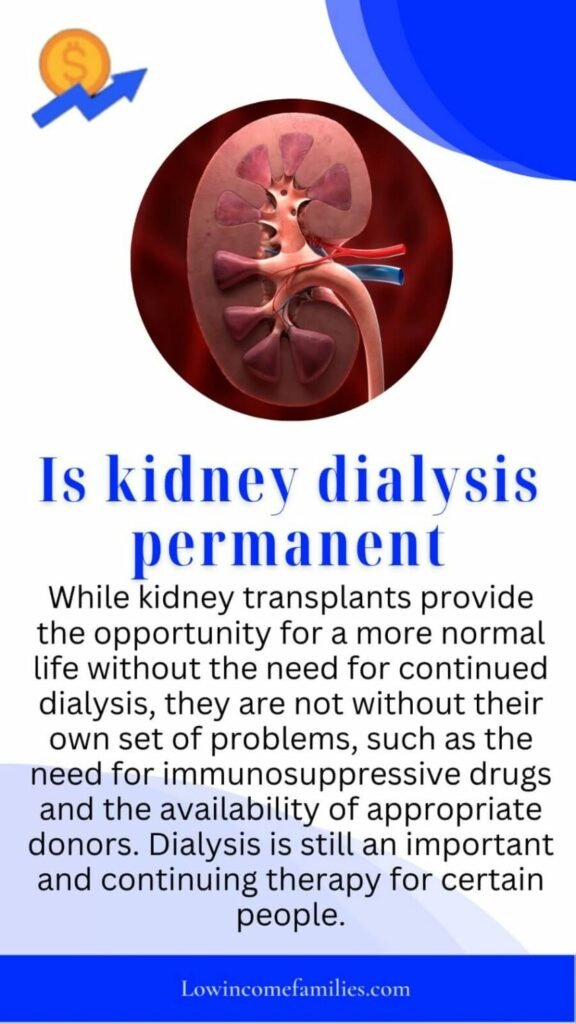Kidney failure, sometimes referred to as end-stage renal disease (ESRD), is a medical condition that requires dialysis as a life-saving medical intervention. Dialysis becomes a continuous medical procedure when the kidneys are unable to filter waste and extra fluid from the circulation. Although dialysis is essential for preserving the health and well-being of persons with ESRD, it is expensive.
In this article, we’ll look at the elements that affect the price of dialysis, the different kinds of dialysis, and how people handle the financial burden of this therapy.
What Is The Price Of Dialysis?
Dialysis is a costly medical treatment, and the price may cause patients and their families a great deal of worry, particularly if they have no insurance or very limited coverage. Here are some further details about the price of dialysis:
-
Cost Without Insurance
A single dialysis treatment costs $500 or more without insurance. Depending on the kind of dialysis, the area, and the particular treatment facility, this might change. In extreme circumstances, the cost of a session can reach $1,000.
-
Insurance Coverage
Regardless of age, most individuals with end-stage renal disease (ESRD) are eligible for Medicare, the government health insurance program in the United States. Medicare usually pays a large amount of dialysis expenses.
Medicare Part A provides inpatient hospital dialysis treatments, and Medicare Part B covers outpatient services. Private health insurance policies often cover dialysis.
However, patients must carefully research their insurance coverage since there may still be out-of-pocket charges, such as deductibles and copayments.
-
Out-Of-Pocket Fees
Even if they have insurance, patients may incur out-of-pocket fees. These costs may include deductibles, copayments, and any dialysis drugs or supplies.
The precise cost depends on the patient’s insurance plan. To assist in paying these extra expenses, some patients may purchase supplementary insurance coverage (Medigap policies).
-
Medicaid
Individuals with ESRD who are low-income may be eligible for Medicaid, a state and federally sponsored programme that offers health care to people who satisfy certain income and eligibility conditions. Medicaid may help pay part of the expenses of dialysis, although the extent of coverage varies by state.
-
Financial Assistance Programs
Many dialysis centres provide financial assistance programs or grants to patients in order to help them pay the cost of treatment. These programs are primarily intended to help persons who are uninsured or in financial difficulty.
-
Home Dialysis
Choosing home dialysis procedures like peritoneal dialysis or home hemodialysis might also help you save money. These approaches minimise the need for frequent dialysis appointments and may be more cost-effective in the long term.
Finally, the cost of dialysis may vary greatly based on criteria such as insurance coverage, region, and kind of dialysis. The costs of not having insurance might be significant.
To handle the financial burden involved with this life-saving therapy, patients should investigate their insurance choices, look into financial help programs, and weigh the possible advantages of home dialysis.
It is critical to be well-informed about available options and to request financial assistance if required to enable access to vital treatment.
Varieties Of Dialysis
Dialysis is a treatment that mimics some of the functions of normal kidneys. There are two forms of dialysis :-
-
Hemodialysis
Hemodialysis is the most often-used kind of dialysis. It entails the use of a machine known as a hemodialyzer to filter the patient’s blood. Hemodialysis is usually done at a dialysis center, a hospital, or even at home if the patient has been taught to use the equipment. Hemodialysis is normally required three times each week, with each treatment lasting around four hours.
-
Peritoneal Dialysis
An alternative to hemodialysis is peritoneal dialysis. It entails using the patient’s peritoneal membrane, which is a lining within the belly, as a natural filter. Patients may do peritoneal dialysis at home on a regular basis, typically while sleeping. This strategy is more adaptable and less disruptive to the patient’s everyday life.
Free Handicapped Transportation Service
Dialysis Cost Influencing Factors
Dialysis costs vary based on a number of parameters, including :-
-
Dialysis Kind
The kind of dialysis a patient gets has a substantial influence on expenses. Hemodialysis, which is usually done in a hospital, is more costly than peritoneal dialysis, which may be done at home.
-
Frequency And Duration
The recommended frequency and length of dialysis treatments differ from patient to patient. Hemodialysis patients often need three treatments each week, but peritoneal dialysis patients typically require daily treatment. The greater the total cost, the more sessions a patient need.
-
Location
Healthcare prices might vary greatly depending on where you live. Dialysis prices may be greater in urban locations with a higher cost of living than in rural ones.
-
Health Insurance
Health insurance is an important factor in calculating out-of-pocket expenditures for dialysis. Medicare, for example, covers most dialysis patients, and commercial insurance plans may also cover it. Those who do not have insurance may face significant financial difficulties.
-
Access To Home Dialysis
Patients who can do peritoneal dialysis at home can save money on transportation and facility expenses connected with in-center hemodialysis.
Does medicaid cover weight loss
Is Kidney Dialysis Permanent?
Individuals with end-stage renal disease (ESRD) may need kidney dialysis for the rest of their lives, but it is not the only therapeutic option. ESRD is the last stage of chronic kidney disease (CKD), occurring when the kidneys can no longer filter waste and excess fluids from the circulation.

Patients generally have two therapy choices at this stage :-
-
Dialysis
Dialysis is a medical therapy that mimics some of the functions of normal kidneys. It aids in the removal of waste and extra fluids from the body. Dialysis may be done in two ways: Hemodialysis, which is usually done in a clinic, and Peritoneal dialysis, which is done at home.
Patients with ESRD may need regular dialysis to be healthy. Dialysis treatments might vary in frequency and length based on the patient’s health.
-
Kidney Transplant
A kidney transplant is another possibility for those with ESRD. A kidney transplant entails replacing the failing kidneys with a healthy kidney from a live or dead donor.
A successful kidney transplant may improve the quality of life for many patients and is regarded a more permanent treatment than dialysis.
The decision between lifelong dialysis and a kidney transplant is based on a number of considerations, including the patient’s health, age, lifestyle, and the availability of a suitable donor.
Because not all ESRD patients are qualified for or have access to a kidney transplant, they may have to depend on dialysis indefinitely. It is critical to speak with healthcare specialists to identify the best treatment approach for each individual’s unique condition.
While kidney transplants provide the opportunity for a more normal life without the need for continued dialysis, they are not without their own set of problems, such as the need for immunosuppressive drugs and the availability of appropriate donors. Dialysis is still an important and continuing therapy for certain people.
Free veterinary care for low income families
Which Dialysis Is The Least Expensive?
When compared to hemodialysis (HD), peritoneal dialysis (PD) is typically regarded the more cost-effective choice. Here are some of the reasons why peritoneal dialysis is typically considered as less expensive :-
-
Home Dialysis
Peritoneal dialysis may be conducted at home, eliminating the need for frequent visits to a dialysis centre. Hemodialysis, on the other hand, is often performed in a clinical environment, which might include transportation and facility expenditures.
-
Fewer Healthcare Personnel
Hemodialysis often need the participation of a group of healthcare professionals, including nurses and technicians, to give care during each session. Peritoneal dialysis is increasingly self-administered, with patients or carers taught to execute the operation, potentially lowering staff expenses.
-
No Requirement For Costly, Specialised Equipment
While peritoneal dialysis necessitates the purchase of dialysis supplies (dialysate fluid, tubing, etc.), it does not necessitate the purchase of costly, specialised equipment such as the hemodialysis machines used in dialysis centres.
-
Lower Overhead Expenses
Overhead expenses related with the facility, equipment upkeep, and personnel are often passed on to patients or their insurance carriers. These expenses do not apply to peritoneal dialysis.
-
Less Regular Monitoring
Due to the in-center aspect of hemodialysis, patients often need more regular monitoring by healthcare experts. Once educated, peritoneal dialysis patients need less frequent physician supervision.
While peritoneal dialysis is often regarded less expensive, it is crucial to highlight that the decision between peritoneal dialysis and hemodialysis should not be based only on cost.
The proper form of dialysis relies on various criteria, including the patient’s health situation, lifestyle, appropriateness for the therapy, and preferences.
Healthcare experts collaborate extensively with patients to select the best kind of dialysis for their unique requirements and circumstances.
Finally, the cost-effectiveness of dialysis varies from patient to patient, therefore individual criteria must be considered while making this choice. Furthermore, healthcare coverage and insurance policies may have a substantial influence on the cost burden of dialysis on a patient.
Does medicaid cover breast reduction
Is Dialysis Available For Free?
Dialysis is a sophisticated medical process that requires the use of specialised equipment, supplies, and experienced healthcare staff, and as a consequence, it is usually expensive.
There are, however, circumstances and programs that may give free or significantly subsidised dialysis treatments to certain persons. Here are some ideas for making dialysis more inexpensive, if not free:
-
Government Support Programs
Government programs such as Medicare and Medicaid in several countries, including the United States, may give financial support to persons with end-stage renal disease (ESRD) to help pay the expenses of dialysis. These programs may greatly minimize the financial burden on qualifying patients.
-
Charity Organisations
Some charity organisations, such as the American Kidney Fund in the United States, provide financial support to kidney disease sufferers to help with the costs of dialysis, drugs, and other associated expenditures.
-
Hospital Charity Care
Some hospitals may have charity care programmes in place to give financial assistance to those who cannot afford dialysis.
-
Clinical Trials
In certain situations, patients may be qualified to participate in dialysis clinical trials, which may give free or subsidized therapy while also contributing to medical research.
-
Community Support
Local communities and nonprofit organizations may organise fundraising events or give assistance to dialysis patients.
-
Insurance Coverage
Comprehensive health insurance, such as Medicare, may greatly lower dialysis patients’ out-of-pocket expenditures. Even if not fully free, the patient’s expense may be significantly reduced.
It is crucial to remember that access to these programmes and opportunities might vary depending on region, individual circumstances, and available resources.
Patients who are worried about the expense of dialysis may contact their dialysis centre or hospital’s healthcare specialists, social workers, or financial counsellors.
These specialists can assist patients in understanding their financial aid choices and navigating the numerous programmes available to alleviate the financial burden associated with dialysis.
How to get tummy tuck for free
Is Dialysis Required Permanently?
Dialysis is not necessarily necessary indefinitely, but it is dependent on an individual’s unique medical condition, the reason of their kidney failure, and the availability of other therapies. The following are the two most common circumstances in which dialysis may be required:
-
Temporary Dialysis
Kidney function may temporarily worsen in certain circumstances as a result of causes such as acute infection, dehydration, or certain drugs.
Dialysis may be required in some cases to maintain the kidneys while the underlying problem is treated. Dialysis may be stopped if the kidneys have recovered and resumed normal function.
-
Chronic Kidney Failure (End-Stage Renal Disease, ESRD)
Dialysis may be necessary on a continuous basis for persons with chronic kidney failure, in which the kidneys have permanently lost their capacity to function effectively. End-stage renal disease (ESRD) is another term for this stage of kidney disease.
ESRD is usually irreversible, and dialysis or kidney transplantation become the only options for survival. Unless the patient obtains a kidney transplant, the necessity for dialysis in ESRD is frequently lifelong.
-
Kidney Transplantation
Kidney transplantation is the most effective long-term therapy for ESRD. A successful kidney transplant may replace the function of failing kidneys, enabling the receiver to live independently of dialysis.
However, not all ESRD patients are transplant candidates, and there is often a waiting list for donor organs. Furthermore, to avoid organ rejection, transplant patients need continuing medical attention and immunosuppressive medicines.
In conclusion, although dialysis is often needed for those with ESRD, it is not always essential. In situations of reversible renal failure, temporary dialysis may be employed, and kidney transplantation can provide a more permanent treatment for certain ESRD patients.
Individual treatment plans are based on their particular medical conditions, preferences, and the availability of appropriate treatment alternatives. Patients should collaborate closely with healthcare providers to develop the best treatment strategy for their specific condition.
How Serious Is Three Times A Week Dialysis?
Consider the following parameters to better understand the gravity of this treatment frequency :-
-
Life-Sustaining Treatment
ESRD is characterised by the loss of most renal function, leading in the buildup of waste products and excess fluids in the body.
Dialysis is a life-sustaining therapy that mimics the critical activities of healthy kidneys, such as the removal of waste and excess fluids from the circulation. Toxic compounds may build up in the body without frequent dialysis, causing major health difficulties and, finally, death.
-
Medical Professionals Determine The Frequency
The recommendation for dialysis three times per week is often based on an individual’s particular medical requirements and is established by healthcare professionals.
This frequency is intended to maintain electrolyte balance and avoid the accumulation of toxic waste products in the body. It is the gold standard of therapy for many ESRD patients.
-
Minimizing Complications
Frequent dialysis treatments assist to reduce the risk of problems associated with ESRD, including as fluid excess, electrolyte abnormalities, and toxin buildup. Dialysis treatments on a regular basis are critical for regulating these issues and guaranteeing the patient’s health and well-being.
-
Quality Of Life
While dialysis is a difficult and time-consuming therapy, it may dramatically enhance the quality of life for those with ESRD. It alleviates symptoms such as tiredness, nausea, and edoema, allowing patients to live reasonably normal lives.
-
Adjustment And Support
Adapting to a three-times-a-week dialysis programme may be physically and emotionally taxing for patients and their families. It may need frequent visits to a dialysis centre, lifestyle changes, and food restrictions.
Patient support, from both healthcare practitioners and the patient’s social network, is critical for managing the effects of this medication.
In conclusion, dialysis three times a week is a critical and necessary medical therapy for those with ESRD. While it may be physically taxing and difficult, it is a lifeline for patients, allowing them to manage their illness, regulate symptoms, and preserve their overall health.
The severity of this therapy emphasizes the need for patient adherence as well as the need for continued support and care from healthcare providers and loved ones.
Conclusion :-
Dialysis is a life-sustaining therapy for those who have renal failure. The expense of dialysis, on the other hand, maybe a considerable financial hardship for patients and their families.
Understanding the variables that determine dialysis costs and investigating available financial assistance alternatives, such as Medicare, Medicaid, and private insurance, is critical for managing the financial issues connected with this necessary medical intervention.
It is critical that healthcare systems and governments continue to strive towards more accessible and inexpensive dialysis solutions, ensuring that all persons in need have access to this life-saving therapy without financial burden.












